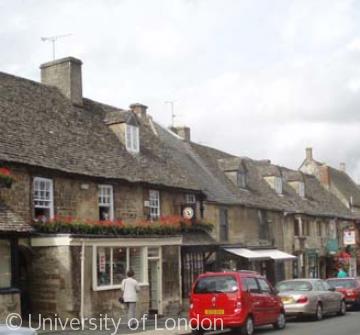High Street (west): Nos 50-56

Behind the 17th- and 18th-century fronts of these four separate houses and shops are remains of more medieval buildings. Nos. 50 and 52 (right), now linked as Jonathan Fyson Antiques, both started as late medieval single-cell units on the street, presumably used as shops. Both have later back wings, and at the side of No. 50 a doorway (which has been reduced in width) leads to the back of the plot. Both were refronted probably in the 17th century, though at No. 52 the large ashlar dressings around the first-floor windows show its separate development.
Nos. 54 and 56, with a higher roofline, were separately refronted in the 18th century, the former in large blocks of carefully squared and smoothed limestone, the latter in squared and dressed limestone rubble blocks, laid in courses of varying widths. No. 54's first-floor windows (datable by their wide glazing bars) were probably part of the same remodelling, though a 17th-century cupboard inside No. 56 suggests an earlier rebuilding too. At No. 54 the refronting hides a medieval timber frame, whilst at No. 56 a two-centred 14th-century archway to the street (see below) points to medieval origins. Visible inside the archway are the timber joists of the room above, and blocked openings on its left may have contained small lock-ups for shops.
Nineteenth-century censuses show all four houses occupied by trades- and craftspeople, including shoemakers, slaters and plasters, tailors, and grocers. The shopfronts (and some first-floor windows) are all 19th- or 20th-century: at No. 56 the ground floor was extended out onto the pavement with a new doorway and shopfront, probably for the watch- and clockmaker Richard Griffin (recorded there 1910). At No. 50, new outbuildings along the edge of the plot included one with a chimneystack, used probably by the blacksmiths (all members of the Barnes family) recorded there from the 1820s to 1850s. The Barneses were succeeded by the Banbury family, who ran a long-lived clothing business and (by 1891) a cycle depot. The building's Cotswold-slate roof contrasts with the 20th-century Welsh slate of No. 52, substituted before the enforcement of guidelines on use of traditional materials.
Content generated during research for the paperback book 'Burford: Buildings and People in a Cotswold Town' (ISBN 13 : 9781860774881) for the England's Past for Everyone series


